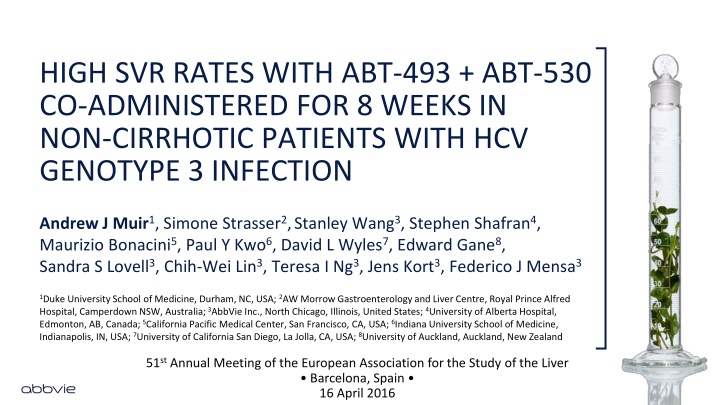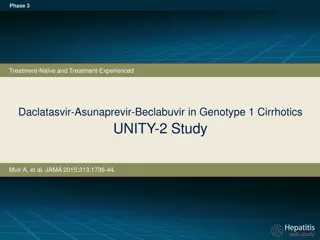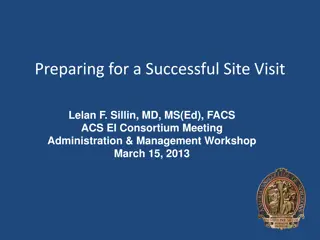
High SVR Rates with ABT-493 and ABT-530 Co-Administered for HCV Genotype 3 Infection
A study presented at the 51st Annual Meeting of the European Association for the Study of the Liver highlighted high sustained virologic response rates with ABT-493 and ABT-530 co-administered for 8 weeks in non-cirrhotic patients with HCV genotype 3 infection. The research was conducted by a team of medical professionals from various institutions. The presentation also includes disclosures of research support and advisory information. The study examined the challenge of treating HCV genotype 3 infections and provided insights into current treatment recommendations for these patients.
Download Presentation

Please find below an Image/Link to download the presentation.
The content on the website is provided AS IS for your information and personal use only. It may not be sold, licensed, or shared on other websites without obtaining consent from the author. If you encounter any issues during the download, it is possible that the publisher has removed the file from their server.
You are allowed to download the files provided on this website for personal or commercial use, subject to the condition that they are used lawfully. All files are the property of their respective owners.
The content on the website is provided AS IS for your information and personal use only. It may not be sold, licensed, or shared on other websites without obtaining consent from the author.
E N D
Presentation Transcript
HIGH SVR RATES WITH ABT-493 + ABT-530 CO-ADMINISTERED FOR 8 WEEKS IN NON-CIRRHOTIC PATIENTS WITH HCV GENOTYPE 3 INFECTION Andrew J Muir1, Simone Strasser2,Stanley Wang3, Stephen Shafran4, Maurizio Bonacini5, Paul Y Kwo6, David L Wyles7, Edward Gane8, Sandra S Lovell3, Chih-Wei Lin3, Teresa I Ng3, Jens Kort3, Federico J Mensa3 1Duke University School of Medicine, Durham, NC, USA; 2AW Morrow Gastroenterology and Liver Centre, Royal Prince Alfred Hospital, Camperdown NSW, Australia; 3AbbVie Inc., North Chicago, Illinois, United States; 4University of Alberta Hospital, Edmonton, AB, Canada; 5California Pacific Medical Center, San Francisco, CA, USA; 6Indiana University School of Medicine, Indianapolis, IN, USA; 7University of California San Diego, La Jolla, CA, USA; 8University of Auckland, Auckland, New Zealand 51st Annual Meeting of the European Association for the Study of the Liver Barcelona, Spain 16 April 2016 1
Disclosures AJ Muir: Research Support/Advisory Board: AbbVie, BMS, Gilead, Janssen, Merck. S Strasser: Advisory board/Speaker: AbbVie, Janssen, MSD, BMS, Gilead, Roche. S Shafran: Research Funding: AbbVie, Boehringer Ingelheim, BMS, Gilead, Janssen, Vertex; Advisory Boards: AbbVie, Boehringer Ingelheim, BMS, Gilead, Janssen, Merck, Pfizer, Roche, Vertex. M Bonacini: Research support: AbbVie, Cubist, Gilead, Intercept, Proteus. Speaker bureau: AbbVie, BMS, Gilead, Merck. PY Kwo: Grant/research support: AbbVie, BMS, Gilead, Janssen, Merck; Advisor: AbbVie, BMS, Gilead, Janssen, Merck. D Wyles: Grant/research support: AbbVie, BMS, Gilead, Merck, Tacere Therapeutics; Consultant/Advisor: AbbVie, BMS, Gilead, Janssen, Merck. E Gane: Advisor: AbbVie, Gilead, Achillion, Novartis, Roche, Merck, Janssen. S Wang, SS Lovell, C-W Lin, TI Ng, J Kort, FJ Mensa: AbbVie employee and may hold AbbVie stock or stock options The design, study conduct, analysis, and financial support of the SURVEYOR-II (NCT02243293) study were provided by AbbVie. AbbVie participated in the interpretation of data, review, and approval of the content. All authors had access to all relevant data and participated in writing, review, and approval of this presentation. Medical writing support was provided by Douglas E. Dylla, PhD, of AbbVie. This presentation contains information on the investigational products ABT-493 and ABT-530. SURVEYOR-II: ABT-493 and ABT-530 for 8 Weeks in Treatment-na ve HCV Genotype 3-infected Patients | EASL | 16 April 2016 2
HCV Genotype 3 (GT3) Higher rates of liver steatosis and an increased risk for hepatocellular carcinoma and fibrosis progression than other HCV genotypes1 Approximately 30% of HCV infections worldwide2 Now the most difficult-to-cure genotype Current EASL recommendations for treatment-na ve GT3-infected patients without cirrhosis SOF + pegIFN/RBV for 12 weeks3 SOF + RBV for 24 weeks3,4 SOF + DCV for 12 weeks5 SVR12, sustained virologic response at post-treatment week 12; SOF, sofosbuvir; pegIFN, pegylated interferon; RBV, ribavirin; DCV, daclatasvir SVR12 96% 90 95% 97% 1. Andriulli A, et al. Aliment Pharmacol Ther. 2008; 28:397-404. 3. Foster GR, et al. Gastroenterology. 2015; 149:1462-70. 5. Nelson DR, et al. Hepatol. 2015; 61:1127-35. 2. Messina JP, et al. Hepatology. 2015; 61:77-87. 4. Zeuzem S, et al. NEJM. 2014; 370:1993-2001. SURVEYOR-II: ABT-493 and ABT-530 for 8 Weeks in Treatment-na ve HCV Genotype 3-infected Patients | EASL | 16 April 2016 3
Next Generation Direct-acting Antivirals ABT-530 Pangenotypic NS5A inhibitor ABT-493 Pangenotypic NS3/4A protease inhibitor High barrier to resistance Potent against common NS3 variants (eg., positions 80, 155, 168) and NS5A variants (eg., positions 28, 30, 31 and 93) Additive/synergistic antiviral activity Once-daily oral dosing Minimal metabolism and primary biliary excretion Negligible renal excretion (<1%) In vitro:1,2 Clinical PK & metabolism: ABT-493 identified by AbbVie and Enanta. 1. Ng TI, et al. Abstract 636. CROI, 2014. 2. Ng TI, et al. Abstract 639. CROI, 2014. SURVEYOR-II: ABT-493 and ABT-530 for 8 Weeks in Treatment-na ve HCV Genotype 3-infected Patients | EASL | 16 April 2016 4
ABT-493 and ABT-530 Have Potent Activities Against All Major HCV Genotypes, Including GT3 Stable HCV GT3a Replicon EC50 nM 1.6 35 6.1 472 19 1162 NS3/4AProtease Inhibitor ABT-493 Grazoprevir1 GS-98572 Simeprevir3,4 Paritaprevir Asunaprevir5 NS5A Inhibitor ABT-530 Elbasvir7 Velpatasvir8 Ledipasvir9 Ombitasvir Daclatasvir10 Odalasvir11 MK-840812 pM 2 140 20 168,000 19 530 48 2 1. Lahser F, et al. AASLD, 2014. 5. McPhee F, et al. AAC, 2012. 9. Cheng G, et al. EASL, 2012 2. Taylor J, et al. EASL, 2015. 6. Yang H, et al. AAC, 2014. 10. Wang C, et al. AAC, 2014. 3. Olysio prescribing information. 7. Liu R, et al. AAC doi:10.1128/AAC.01390-15 11. ACHN R&D/Analyst Day 4. Chase R, et al. IAPAC, 2013. 8. Cheng G, et al. EASL, 2013. 12. Asante-Appiah E, AASLD, 2014. SURVEYOR-II: ABT-493 and ABT-530 for 8 Weeks in Treatment-na ve HCV Genotype 3-infected Patients | EASL | 16 April 2016 5
ABT-530 Retains Antiviral Activity Against Common GT3 Single- Position NS5A Variants Fold Change in EC50 for GT3 NS5A Variants M28T A30K 0.4 1.1 NA >1000 NA 10 100 46 56 - 62 NA 50 423 NA NA NA NA NA NS5A Inhibitor Y93H 2.5 >1000 >100 2738 2752 486 6728 NA NA ABT-530 Ledipasvir1 Velpatasvir2 Daclatasvir3 Elbasvir4 Ombitasvir5 Odalasvir MK-8408 NA, not available 1. Hernandez D, et al. J Clin Virol, 2013. 4. Gane E, et al. EASL, 2015. 2. Doehle BP, et al. EASL, 2015. 5. Krishnan P, et al. AAC, 2015. 3. Wang C, et al. AAC, 2013:57:611-3. SURVEYOR-II: ABT-493 and ABT-530 for 8 Weeks in Treatment-na ve HCV Genotype 3-infected Patients | EASL | 16 April 2016 6
Prior Results in Patients With GT3 Infection, and Objective 97 93 97 89 100 Dose-ranging part 1 of this study with ABT-493 300 mg + ABT-530 120 mg resulted in 97% (28/29) mITT SVR12 in treatment-na ve or -experienced patients without cirrhosis treated for 12 weeks1 90 80 SVR12, % Patients 70 60 50 40 30 20 28 29 28 30 29 30 25 28 10 0 ABT-493 ABT-530 300 120 200 120 200 120 RBV 200 40 12 Weeks Objective: Explore whether a shorter 8-week treatment duration with ABT-493 + ABT-530 would result in a similarly high SVR rate in treatment-naive GT3-infected patients without cirrhosis 1. Kwo PY, et al. AASLD, 2015. SURVEYOR-II: ABT-493 and ABT-530 for 8 Weeks in Treatment-na ve HCV Genotype 3-infected Patients | EASL | 16 April 2016 7
SURVEYOR-II Part 2 Study Design Partially randomised, open-label, multicentre phase 2 trial evaluating the dose combination of ABT-493 300 mg and ABT-530 120 mg identified in the dose-ranging part 1 of this study *RBV dosed once-daily. Blue diamond = randomised arms. SURVEYOR-II: ABT-493 and ABT-530 for 8 Weeks in Treatment-na ve HCV Genotype 3-infected Patients | EASL | 16 April 2016 8
SURVEYOR-II Part 2 Study Design Partially randomised, open-label, multicentre phase 2 trial evaluating the dose combination of ABT-493 300 mg and ABT-530 120 mg identified in the dose-ranging part 1 of this study *RBV dosed once-daily. Blue diamond = randomised arms. SURVEYOR-II: ABT-493 and ABT-530 for 8 Weeks in Treatment-na ve HCV Genotype 3-infected Patients | EASL | 16 April 2016 9
Key Eligibility Criteria and Endpoints Key inclusion criteria 18 to 70 years of age, inclusive HCV GT3 infection, HCV RNA >10,000 IU/mL Absence of cirrhosis Key exclusion criteria Any prior HCV treatment HIV co-infection Herbal supplements and potent P-gp inducers were prohibited Endpoints Efficacy: SVR12 (primary) and virologic failure Safety: adverse events (AEs) and laboratory abnormalities SURVEYOR-II: ABT-493 and ABT-530 for 8 Weeks in Treatment-na ve HCV Genotype 3-infected Patients | EASL | 16 April 2016 10
Demographics and Patient Characteristics ABT-493 + ABT-530 (N = 29) 15 (52) Male, n (%) Race, n (%) White Black Hispanic/Latino, n (%) Age, mean years (range) BMI, mean kg/m2, SD HCV RNA, median log10 IU/mL (range) HCV GT3a*, n (%) Baseline fibrosis stage, n (%) F0 F1 F2 F3 * Genotypes were determined using the Versant HCV Genotype Inno-LiPA Assay, version 2.0 or higher. Subgenotype (per the central lab) was not determined for 3 patients. 26 (90) 1 (3) 2 (7) 47 (27 66) 26 3.8 6.5 (5.0 7.5) 25 (86) 20 (69) 2 (7) 7 (24) SURVEYOR-II: ABT-493 and ABT-530 for 8 Weeks in Treatment-na ve HCV Genotype 3-infected Patients | EASL | 16 April 2016 11
Baseline Variants in NS3 and NS5A ABT-493 + ABT-530 (N = 28*) 13 (46) 10 2 1 Any variants, n (%) NS5A only, n NS3 only, n Both NS3 and NS5A variants, n * Sequencing pending for 1 patient. Variants detected by population sequencing (detection threshold of 15%) NS3 variants: A166S (n = 3) NS5A variants: Y93H (n = 5) A30K/S/V (n = 5) P58A/T (n = 2) Variants detected by population sequencing (detection threshold of 15%) at the following amino acid positions that confer resistance to at least 1 DAA in the inhibitor class were included in the analysis; they may not confer resistance to ABT-493 or ABT-530. NS3: 36, 56, 80, 155, 156, 166, and 168 NS5A: 24, 28, 29, 30, 31, 32, 58, 92, and 93 SURVEYOR-II: ABT-493 and ABT-530 for 8 Weeks in Treatment-na ve HCV Genotype 3-infected Patients | EASL | 16 April 2016 12
SVR12 Analysis No virologic failures 97 100 100 90 1 patient withdrew consent after treatment week 6 due to intolerance of blood draws and had an undetectable HCV RNA at the time of discontinuation 80 SVR12, % Patients 70 60 50 40 30 20 28 29 28 28 10 0 SVR12 mITT SVR12 mITT SVR12 rate excludes non-virologic failures SURVEYOR-II: ABT-493 and ABT-530 for 8 Weeks in Treatment-na ve HCV Genotype 3-infected Patients | EASL | 16 April 2016 13
Summary of Adverse Events ABT-493 + ABT-530 (N = 29) 22 (76) 0 0 Event, n (%) Any AE AE leading to study drug discontinuation Serious AE Common AEs* Headache Fatigue Diarrhoea Insomnia Oropharyngeal pain Toothache * Occurring in 10% of patients 5 (17) 3 (10) 3 (10) 3 (10) 3 (10) 3 (10) SURVEYOR-II: ABT-493 and ABT-530 for 8 Weeks in Treatment-na ve HCV Genotype 3-infected Patients | EASL | 16 April 2016 14
Laboratory Abnormalities ABT-493 + ABT-530 (N = 29) 0 0 Event, n ALT, grade 2 (>3 ULN)* AST, grade 2 (>3 ULN)* Total bilirubin Grade 2 (>1.5 3 ULN) Grade 3 (>3 ULN) Alk phos, grade 2 (>2.5 ULN) Haemoglobin, grade 2 (<10 g/dL) * Post nadir 1 0 0 0 In all patients with baseline ALT elevations, ALT levels normalized with treatment and no on-treatment ALT elevations were observed No grade 3 or 4 abnormalities were observed SURVEYOR-II: ABT-493 and ABT-530 for 8 Weeks in Treatment-na ve HCV Genotype 3-infected Patients | EASL | 16 April 2016 15
Summary and Conclusions 8-week treatment with once-daily ABT-493 and ABT-530 achieved 97% SVR12 in treatment-na ve GT3-infected patients without cirrhosis There were no virologic failures; 100% mITT SVR12 High efficacy was achieved regardless of baseline viral load or presence of baseline NS3 and/or NS5A variants This combination was well tolerated, with mostly mild AEs, no serious AEs, no significant laboratory abnormalities, and no discontinuations due to AEs SURVEYOR-II: ABT-493 and ABT-530 for 8 Weeks in Treatment-na ve HCV Genotype 3-infected Patients | EASL | 16 April 2016 16
Additional Data at EASL 12 weeks in GT3 with cirrhosis; late breaker session ENDURANCE-3: active-comparator study to daclatasvir + sofosbuvir in GT3-infected patients; Trials in progress poster THU-482 12 weeks in GT1 with cirrhosis: 96% SVR12*; Poster SAT-135 8 weeks in GT1 or 2 without cirrhosis: 100% SVR12*; Poster SAT-157 12 weeks in GT4 6 without cirrhosis: 100% SVR12; Poster SAT-137 *mITT analysis SURVEYOR-II: ABT-493 and ABT-530 for 8 Weeks in Treatment-na ve HCV Genotype 3-infected Patients | EASL | 16 April 2016 17
Based on These Data, ABT-493 and ABT-530 are Being Evaluated as a Pangenotypic RBV-free Regimen SURVEYOR-II: ABT-493 and ABT-530 for 8 Weeks in Treatment-na ve HCV Genotype 3-infected Patients | EASL | 16 April 2016 18
Acknowledgements The authors would like to express their gratitude to the patients and their families who participated in this study. Additionally, we would like to acknowledge the AbbVie Clinical Virology team, all members of the SURVEYOR-II study team, and AbbVie s HCV Next Generation team who contributed to this study. SURVEYOR-II: ABT-493 and ABT-530 for 8 Weeks in Treatment-na ve HCV Genotype 3-infected Patients | EASL | 16 April 2016 19











